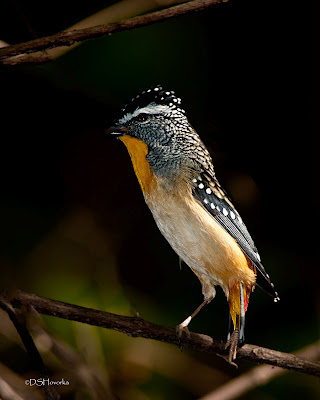 |
| Noisy Pitta |
Quick now, how do I get this flash turned off?
Today I was headed back to the car to go to the Uni and this Spotted Pardalote (who I had been tracking by his call through the bush for 30 min) suddenly landed on a branch 30 feet away and called and called and called (note the erect posture and raised "mohawk". It is hard to believe such a tiny bird makes a call you hear 1 km away!). But this photography stuff is a long game - he would not turn to let me get a photo of his spectacular red tail feathers!
 Usually -just- too far for a good picture, the Red- Backed fairy Wren has previously only offered very brief close views. But at Eagleby this beautiful guy came to sit on a branch for about 60 secs.
Usually -just- too far for a good picture, the Red- Backed fairy Wren has previously only offered very brief close views. But at Eagleby this beautiful guy came to sit on a branch for about 60 secs.Another on my list of distant canopy feeders, I finally found this Scarlet Honeyeater lower in the branches.
At Sundown the banksia were in bloom and there were dozens of New Holland Honeyeaters.
I know the feeling -a remarkable yawn (!) from a Black Shouldered kite. (really now, do birds yawn?)

The Red Browed finches are about in force. It is great fun to see them out in the clear









